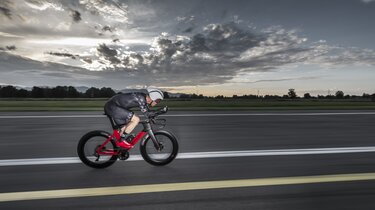To be able to compare the drag of different road bikes in a neutral, qualified and reproducible method, specialist journals conduct wind tunnel measurements. By doing so, they do their best to create comparable conditions under which different bike models compete against each other. For each tested bike, the amount of energy in watts is calculated which is required to maintain a defined speed against the airflow.
The TOUR test
The editorial team of the TOUR magazine place a "pedalling" lower body dummy on the bike. The air resistance is measured at an approach speed of 45 km/h at various angles from -20 to +20 degrees to the front. This standard also takes into account the turbulence caused by a human body on the road bike. (Read more about TOUR's test protocol. (German only)) Despite the standardised testing procedure, the interpretation of the wind tunnel test requires a certain amount of caution: for marketing purposes, some manufacturers send their bikes in a configuration with limited functionality to the wind tunnel. The PRIDE II, on the other hand, rolled into the wind tunnel for the TOUR test fully equipped for real-world use: The test bike in medium frame size 55 was fitted with competition-ready gearing with two chainrings and front derailleur, as well as a 400 millimetres wide handlebar that to match the frame size. Nevertheless, at 199 watts, it broke the 200 watt sound barrier for the first time and is still unbeaten today.
Read the test report (German)
The RennRad test
RennRad magazine report the results of their direct comparison wind tunnel test of 10 current aero race bikes without a dummy in its 7/2024 issue. RennRad also focussed on the air resistance at 45 km/h. Also in this test, the PRIDE II emerged as the winner in the "real crosswind" protocol (+/- 20 degrees) with 63.0 watts - even though some competitors had sent their test model to the test with a lower frame height and higher wheel rims.
Read the test report (German, PDF)











